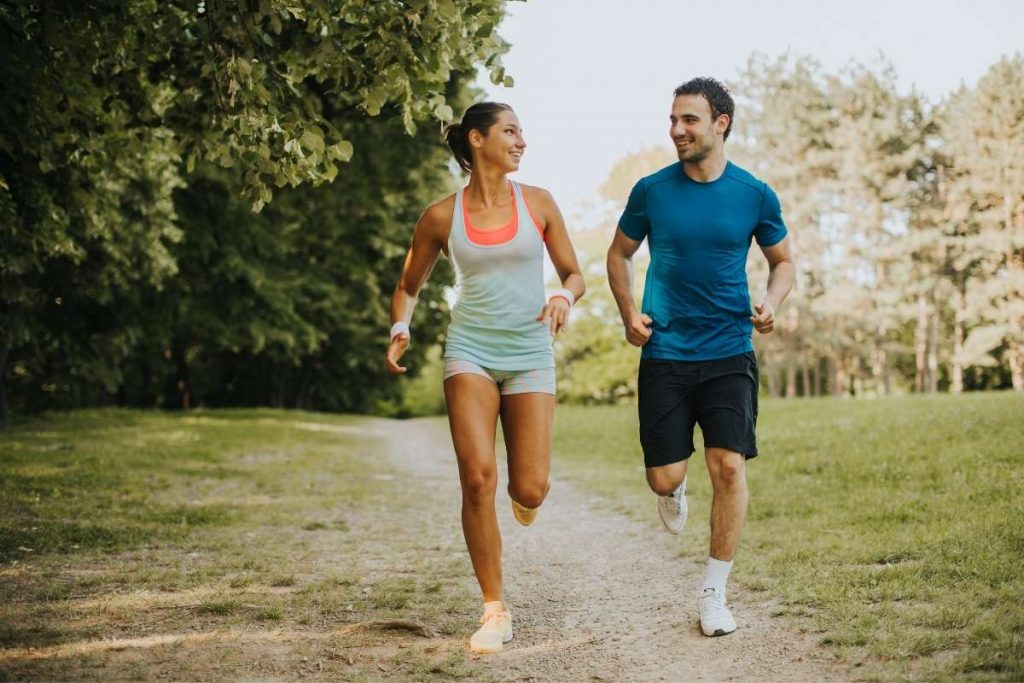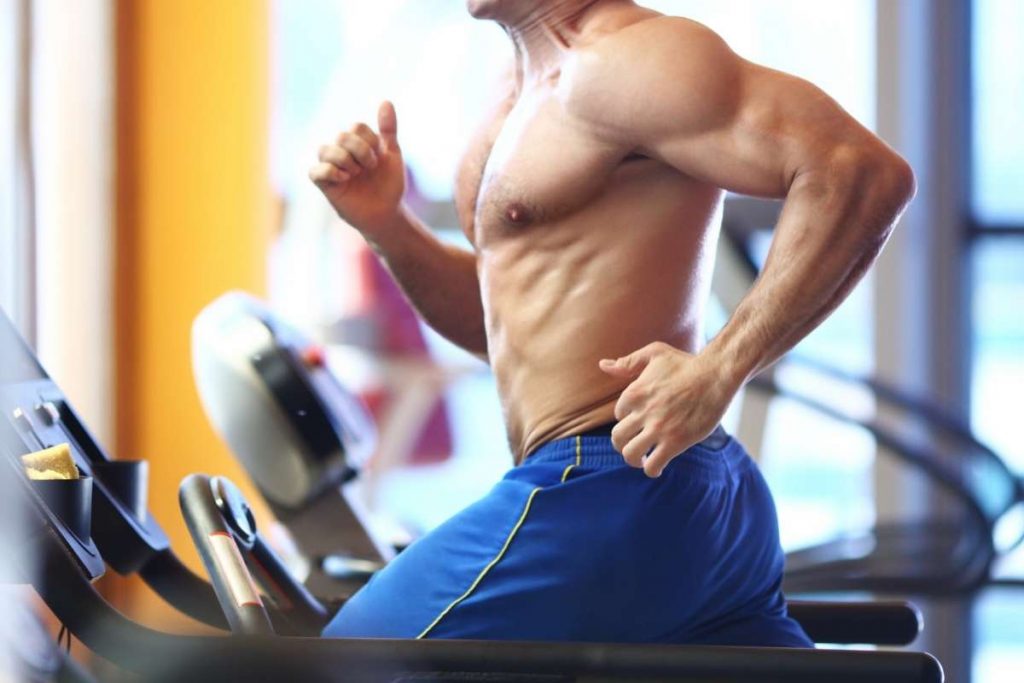What's inside
Since the running boom in the 1970s, the sport has taken many forms. Many longtime runners stay committed due to its mental and physical health benefits.
One of which is losing weight.
In fact, before the rise of gym culture and resistance training, running was considered the ultimate way to lose belly fat.
It makes sense, given that dedicated runners tend to be much slimmer than others.
However, recently, resistance training, high protein diets, and calorie deficits have been the most popular ways to lose fat. More people look at the treadmill as a warm-up or weekly cardio fix.
So the question remains, does running burn belly fat? If so, is it the best way for you to lose belly fat?
In today’s article, I’m going to share the truth about running and whether you should use it to burn belly fat.
Let’s jump in.
Does running burn belly fat?
Related: Does Cardio Burn Muscle?
Running does burn belly fat.
Scientific research notes that performing bouts of short-term, high-intensity aerobic exercise is an effective way to burn belly fat.
Further research bolsters this, noting that high intensity is more effective in reducing abdominal fat.
What are the different styles of running?
Related: What is The 75 Hard Challenge

Running is a great way to reduce belly fat and improve overall health. But what type of running you do may influence how much you lose – and how fast.
Here are a few main types.
Normal (Base) Running
Normal running, or base running, is described as the main body of the runs that you’ll perform during the week.
It is performed at a relaxed pace and is used to improve endurance and aerobic capacity, with these runs making up the bulk of your training.
Long Running
A long run is a base run with more distance. The aim is to challenge the runner’s tolerance levels and improve endurance.
Depending on the goal distance, long runs can range from 8km-16km (5-10 miles) for those training for a half marathon and 32kms (20 miles) for training for a full marathon.
Interval Running (High-Intensity Running)
Interval running is characterized by shorter, high-intensity runs followed by breaks or lower-intensity runs, walks, or rest.
The aim of this style of running has been shown to increase endurance and power performance and is used to increase speed.
These can be done by performing 10 x 400m (0.4 miles) for shorter intervals and 5 x 1000m (0.62 miles).
Hill Repeats Running
This style typically consists of running up a hill for 30-60 seconds at high intensity, followed by a two-minute active recovery.
This form of high-intensity training illustrates the benefits of distance running. Many runners use it to increase power, strength, and tolerance.
Recovery Running
Recovery running is performed as a means to recover from a longer, more intense run.
These are done for a short time (five minutes, for instance) at a relaxed pace.
Progression Running
Progression running is performed with the intention of training for longer distances.
These runs begin at a more relaxed pace which is sustained for the main body of the session, followed by more intense running towards the closing end of the session.
This is the way to train endurance, fatigue, and speed.
Does running burn more calories than other exercises?
Related: Love Handle Workout
Running has been indicated to have a greater effect on reducing burning calories than other exercises.
A 2012 study compared the effects of aerobic training and resistance training.
Aerobic training was seen to be more beneficial for burning fat mass and body mass, while resistance training was shown to increase lean body mass and reduce fat mass.
Further research indicated endurance running to be a more effective way to expend calories than weights or cycling.
How does running burn belly fat?
Related: 13 Best Fat Burners for Women
When we run, our body uses carbohydrates to fuel our performance.
When these stores have been depleted the body will begin to use fatty acids for fuel.
Fortunately for us, when we consistently perform aerobic exercise, such as running, our body mobilizes lipids (fatty acids).
When this happens, the fatty acids are released to provide fuel for working muscles.
Studies show that following these sessions fat is metabolized at rest and at lower intensities. This is due to the depletion of carbohydrate stores.
Sample Running Program for Burning Belly Fat
Related: Hypertrophy Vs Strength Training

You can run to kickstart your fat-burning, and I’ve created a program to get you going.
If you’re worried it’ll be too boring, the variety will help to keep your training fresh and recover. Plus, each session will be created for a beginner runner, so don’t worry about a lack of experience.
High-intensity sessions such as intervals and hill repeats have been shown to increase fat loss.
Baserunning and long runs will improve your running while burning calories over a longer duration and post-training.
| Mon | Tues | Wed | Thurs | Fri | Sat | Sun |
| Base | Hills | Rest | Intervals | Rest | Long Run | Rest |
Base Running Session
| Exercise | Intensity | Duration |
| Warm-Up | low | 5 |
| 3km Run (1.85 miles) | moderate | 20 – 30 minutes |
| Recovery Run | low | 3 |
| Cool Down/Stretch | low | 5 |
Hills Repeat Session
| Exercise | Intensity | Duration | Rest |
| Warm-Up | low | 5 | |
| 10 x 45-60 second hill sprints | high | 2 min recovery between reps | |
| Recovery | low | 3 | |
| Cool Down/Stretch | low | 5 |
Intervals Session
Pick one of the listed intervals for each session and alternate.
This will help to improve your capacity for speed and endurance.
| Exercise | Intensity | Duration |
| Warm-Up | low | 5 |
| 3 x 1000m (0.6 miles) | High | 2 minutes |
| 6 x 400m (0.25 miles) | High | 2 minutes |
| Recovery Run | low | 3 |
| Cool Down/Stretch | low | 5 |
Long Run Session
Long runs are scheduled once per week following a shorter interval day and rest day.
This will allow you to recover prior or your long run.
| Exercise | Intensity | Duration |
| Warm-Up | low | 5 |
| 5km-8km (3-5 miles) | moderate | 60 Minutes |
| Recovery Run | low | 3 |
| Cool Down/Stretch | low | 5 |
Want to kickstart your fat burning? Check out The Ultimate Guide To Boosting Your Metabolism
9 Best Exercises to Improve Running And Prevent Injuries
Related: How To Lose a Pound a Day
Below is a list of the nine best exercises to improve your running and prevent injuries. These will help ensure your body is in peak condition to burn belly fat.
1. Dynamic Hip Flexor Stretch
The dynamic hip flexor stretch is used to lengthen the muscles at the front of the hips and quadriceps.
This movement helps us to lengthen the tissue at the front of the thigh that can become restricted from sitting for long durations.
Lengthening these fibers will allow for great activation of the glutes, which are vital to your running.
Equipment Requirements
- Mat
- Floor Space
How To Perform Dynamic Hip Flexor Stretch
- Position yourself on the mat in a half-kneeling position, with knees bent at 90 degrees.
- With a proud chest, and hands-on-hips gently rock forward until you feel a stretch at the front of the hips.
- Rock back to the starting position. Repeat.
Benefits
- Warms up and stretches hip flexors
- Gentle movement
Pro Tips
- When performing the hip flexor rock gently rock into the stretch. This will help gradually release tissue.
- With each rock, focus on breathing, exhaling as you rock forward and inhaling as you rock back. This will allow your body to relax into the stretch.
2. Frog Stretch
The frog stretch targets the adductor muscles that are located on our inner thighs. Due to sedentary lifestyles and exercise routines, these muscles often become restricted.
Gently releasing them with the frog stretch allows them to lengthen and warm them up for your running session.
Equipment Requirements
- Mat
- Floor Space
How To Perform Frog Stretch
- Kneel on the mat with knees in line, shoulder-width apart, with elbows making contact with the floor.
- Gently rock hips backward until you feel a stretch through the inner thigh.
- Rock forward into the starting position. Repeat.
Benefits
- Warms up and stretches the adductors
- Improves knee tracking and glute activation while running
Pro Tips
- When rocking back, focus on pushing hips back. This will help target the adductors and allow them to relax and release.
- Concentrate on your breathing, exhaling as you rock back and inhaling when you rock forward. This will allow you to relax, and increase your stretch.
3. Leg Swings
Leg swings are a great movement to perform before running. They warm up our legs and hips and mimic the upcoming movements we are about to perform.
Equipment Requirements
- Post for balance
How To Perform Leg Swings
- Stand front on to a post, lean slightly forward, and hold the post for balance.
- Allow one leg to hang, foot held off the ground, and swing it side to side across the body.
- Repeat for both sides.
Benefits
- Warms up and stretches the adductors and hip flexors
- Mimics running movement, prepares muscles and joints for running session
Pro Tips
- When performing swings, allow momentum to carry the leg through the movement. This will help the muscles relax and release.
- Focus on breathing. This will help take your mind off technique and increase your ability to relax.
4. Hips Raises
Running for fat loss isn’t all stretching and sprinting. Strengthening the muscles you need to run will carry you even further. And hip raises are a simple bodyweight exercise to get you going.
Hips raises are used to activate the glutes, which are vital to running. While running, it’s our glutes that are responsible for pushing off and striding through.
Activating our glutes prior to the session will ensure they perform for us during our run.
Equipment Requirements
- Floor Space
- Mat
How To Perform Hip Raises
- Lie on your back on the mat with hands by your side, knees bent at 90 degrees, and feet flat on the floor.
- Tense glutes and lift your hips up off the floor.
- Raise hips until your legs and torso form a straight line. Pause for a second.
- Gradually lower to the starting position. Repeat.
Benefits
- Activates glute
- Brings focus to glute, which can help with running performing
Pro Tips
- Lift the hips instead of pushing through the legs. This will help draw focus to the glute.
- Focus on glute contraction through the entire movement to build your mind-muscle connection.
5. Calf Raises
Calf raises are one of the most effective ways to warm up the muscles of our lower leg and ensure they are firing during our runs.
The calf is responsible for pushing off and landing and must brace for impact with each stride.
Strengthening it between running sessions and warming it up prior will not only reduce injury but prepare it to perform.
Equipment Requirements
- Floor/Step
- Wall (balance)
How To Perform Calf Raises
- Holding a wall for balance, push through the toes and lift the heels off the floor.
- At the top, pause for a second and squeeze the calf muscle.
- Gradually lower. Repeat.
Benefits
- Activates calves
- Reduces calf injury
Pro Tips
- Focus on contracting the calf muscle at the top of the movement.
- If these are too easy, consider performing the same movement with one leg to increase resistance.
6. Goblet Squats
Goblet squats are a squat variation targeting the quadriceps and glutes while engaging the core and reducing spinal load.
This makes them a great exercise for running, as you can strengthen these muscles with less knee and spine joint stress.
Equipment Requirements
- Floor/step
- Dumbbell/kettlebell
How To Perform Goblet Squats
- Stand upright with feet shoulder-width apart.
- Hold a dumbbell vertical under your chin.
- To begin, push hips back and lower until they are parallel with the floor.
- Push through legs and return to the upright position. Repeat.
Benefits
- Strengthens quadriceps and glutes
- Decreased spinal loading
- Weight helps you stay upright through the entire movement
Pro Tips
- At the top of each repetition, squeeze glutes. This will draw focus to them and improve contraction.
- Before each repetition, inhale and tense your core. This will help create pressure through the body to help brace for the weight.
7. Nordic Hamstring Curls
Nordic hamstring curls are seen as one of the most effective ways to strengthen hamstrings and reduce injury.
This movement is an absolute must, as it will prevent injury and help you stick to your running schedule to lose belly fat.
Equipment Requirements
- Mat
- Barbell
- Weight Plate
- Shoulder Pad (Barbell pad)
How To Perform Nordic Hamstring Curls
- Set up a barbell with enough weight to anchor your body weight.
- Kneel on a mat facing away from the mat and tuck calves under the barbell so they’re making contact with the barbell pad.
- To begin the movement, gradually lean forward from the knees up.
- Aim to gradually lower yourself to the floor.
- Lower until you cannot hold anymore and allow yourself to drop to the floor in front of you.
- Push yourself back up to the upright position. Repeat.
Benefits
- Prevents hamstring injuries
- Strengthens hamstrings
Pro Tips
- Beginners can place a chair or bench in front of them to reduce the distance of lowering. This will allow you to get comfortable with the movement.
- Exhale as you lower and focus on lowering with both hamstrings. This will ensure both are working correctly.
8. Reverse Nordics
Reverse Nordics are used to strengthen the quadriceps and prevent injury.
As we use our quads and hips at high repetitions while we run, it’s essential that we train to strengthen them outside of our running schedule.
Equipment Requirements
- Mat
How To Perform Reverse Nordics
- Kneeling on the mat, knees bent at 90 degrees, keep the top of feet making contact with the mat with the torso upright.
- Begin by lowering yourself backward from the knees.
- Gradually lower until hips make contact with heels.
- Push through legs and return to the upright kneeling position. Repeat.
Benefits
- Reduces quadricep injuries
- Strengthens quadriceps
Pro Tips
- Beginners can test their range with half repetitions. This will help familiarize you with the movement and sensation of the contraction.
- When lifting back to the upright position, imagine straightening your legs out. This will help target the muscles of the quadriceps.
9. Tibialis Raises
The tibialis anterior is the muscle that is located at the front of the shin. This muscle runs down the shins and attaches to the foot and is responsible for bracing impact.
Unfortunately, it’s often passed over when we train.
But by performing tibialis raises, we can strengthen and prepare the fibers for running.
Equipment Requirements
- Wall
How To Perform Tibialis Raises
- Lean with your back against a wall and your feet angled out in front of you.
- Lift toes up toward your body with the weight of your body resting on your heels.
- Raise toes until the ankle is flexed at 90 degrees.
- Gradually lower to the starting position. Repeat.
Benefits
- Strengthens tibialis anterior
- Helps with strengthening calves for impact
Pro Tips
- Beginners start with a slight lean. This will reduce the resistance and allow you to perform your raises to a full range of motion.
- If you’re having trouble lifting your toes with shoes, take them off. This will help the heel rock for a more fluid movement.
The Best Diet Plan to Burn Belly Fat
Related: How To Lose Upper Body Fat

Running to burn belly fat is more than just miles we put into our workouts; the food we consume matters, too.
Eating the right amount of calories and macronutrients is essential to weight loss, performance, and recovery.
The below calorie breakdowns are based on the average male and female participating in moderate exercise two to four times per week.
The aim is to lose 1lb (0.5kg) per week.
The recommended caloric intake is 2,500 for males and 2,000 for females.
When running for fat loss, we want to create a calorie deficit while still providing the body with enough energy to perform.
A deficit of 200-300 calories is recommended to lose 1lb (0.5kg) per week.
To hit protein targets, a protein supplement may be used, but it’s not mandatory.
For your own calorie and macronutrient breakdown try this macro calculator.
Calorie and Macro Breakdown
The figures below are based on profiling the following profile:
- Male, 25 years old, 180cm (5’ 9”), 220lbs
- Female, 25 years old, 170cm (5’ 5”), 200lbs
| Macronutrient | Percentage | Male | Female |
| Calories | 2257 cal | 1800 cal | |
| Protein | 25% | 141g | 112g |
| Carbohydrates | 50% | 310g | 225g |
| Fats | 25% | 63g | 50g |
7-Day Meal Plan
Here is a 7- day sample meal plan complete with macronutrient breakdown.
Days that contain lean meat for dinner have more balanced macros throughout the day.
Days with low-fat spaghetti, burgers, and pizza for dinner will have lower carb intakes throughout the day, reserving more carbs for dinner.
A cheat meal is planned for Saturday evening. This is a planned guilt-free meal requirement to help you stay sane.
So stay in for your favorite take-out meal, or head out with some friends and reward yourself for your weekly progress.
Monday
| Meal | Food | P (M/F) | C(M/F) | F(M/F) |
| Meal 1 | Oatmeal, Protein, Nuts | 35g/28g | 77g/56g | 16g/12.5 |
| Meal 2 | Chicken Breast, Salad, Vegetables, Brown Rice | 35g/28g | 77g/56g | 16g/12.5 |
| Meal 3 | Chicken, Fish, Vegetable, Rice, Sweet Potato | 35g/28g | 77g/56g | 16g/12.5 |
| Snack | Protein Shake, Fruit, Nuts | 35g | 77g/56g | 16g/12.5 |
Tuesday
| Meal | Food | P (M/F) | C(M/F) | F(M/F) |
| Meal 1 | Oatmeal, Protein, Nuts | 35g/28g | 50g/33g | 16g/12.5 |
| Meal 2 | Grilled Chicken Salad | 35g/28g | 30g/22g | 10g/8 |
| Meal 3 | Spaghetti with Lean Beef | 35g/28g | 124g/90g | 22g/17 |
| Snack | Protein Shake, Fruit, Nuts | 35g | 77g/56g | 16g/12.5 |
Wednesday
| Meal | Food | P (M/F) | C(M/F) | F(M/F) |
| Meal 1 | Oatmeal, Protein, Nuts | 35g/28g | 77g/56g | 16g/12.5 |
| Meal 2 | Chicken Breast, Salad, Vegetables, Brown Rice | 35g/28g | 77g/56g | 16g/12.5 |
| Meal 3 | Chicken Stir Fry | 35g/28g | 77g/56g | 16g/12.5 |
| Snack | Protein Shake, Fruit, Nuts | 35g | 77g/56g | 16g/12.5 |
Thursday
| Meal | Food | P (M/F) | C(M/F) | F(M/F) |
| Meal 1 | 2 Egg Omelet (Low fat cheese) Salad, Protein | 35g/28g | 31g/22g | 16g/12.5 |
| Meal 2 | Grilled Chicken Breast, Salad, Brown Rice | 35g/28g | 77g/56g | 10g/8 |
| Meal 3 | Low Fat Chicken Pizza (Low fat cheese and base) | 35g/28g | 123g/90g | 22g/17 |
| Snack | Protein Shake, Fruit, Nuts | 35g | 77g/56g | 16g/12.5 |
Friday
| Meal | Food | P (M/F) | C(M/F) | F(M/F) |
| Meal 1 | Oatmeal, Protein, | 35g/28g | 77g/56g | 16g/12.5 |
| Meal 2 | Chicken Salad Sandwich | 35g/28g | 77g/56g | 16g/12.5 |
| Meal 3 | Lemon Baked Salmon, Vegetable, Rice, Sweet Potato | 35g/28g | 77g/56g | 16g/12.5 |
| Snack | Protein Shake, Fruit, Nuts | 35g | 77g/56g | 16g/12.5 |
Saturday
| Meal | Food | P (M/F) | C(M/F) | F(M/F) |
| Meal 1 | Oatmeal, Protein, Nuts | 35g/28g | 77g/56g | 16g/12.5 |
| Meal 2 | Tuna Salad, Brown Rice | 35g/28g | 77g/56g | 16g/12.5 |
| Meal 3 | Cheat Meal | |||
| Snack | Protein Shake, Fruit, Nuts | 35g | 77g/56g | 16g/12.5 |
Sunday
| Meal | Food | P (M/F) | C(M/F) | F(M/F) |
| Meal 1 | 2 Egg Omelet, Protein | 35g/28g | 30g/22g | 16g/12.5 |
| Meal 2 | Chicken Breast, Salad, Vegetables, Brown Rice | 35g/28g | 77g/56g | 10g/8 |
| Meal 3 | Lean Beef Burger (Whole Grain Rolls), Baked Sweet Potato Fries | 35g/28g | 123g/90g | 22g/17 |
| Snack | Protein Shake, Fruit, Nuts | 35g | 77g/56g | 16g/12.5 |
*The nutrition and dietary breakdowns listed are for example only. If you wish to undertake a fat-burning nutrition plan please seek advice from a licensed healthcare professional.
If you require a protein supplement to increase your daily intake, check out Top 14 Best Protein Powder Without Artificial Sweetener
Health Benefits of Running
Related: How To Burn 1000 Calories Per Day
Losing fat is far from being the only benefit of running. There are several other reasons you should incorporate it into your training, no matter your fitness goals.
Decreases Stress
Aerobic exercises have long been a great way to relieve stress.
The common research finding is that people who perform aerobic exercise for 20-30 minutes feel calmer after their session, and for many hours after.
Improves Mental Health
Running has been noted to improve mental health, with research identifying the improvement of anxiety and depression.
Regular running leads to increased self-esteem, positive mood changes, and decreased anxiety.
Prevents Bone Fragility
Running is an excellent way to increase bone density and reduce bone fragility.
The act of running itself improves coordination, balance, and reduces fall-related fractures.
This reduces the occurrence of disability and mortality.
Reduce Risk of Cardiovascular Disease
It’s no surprise that running can get the heart pumping. Like any muscle that’s trained, it can increase heart health.
The research strongly indicates that running as little as 5-10 minutes a day is linked to a decrease in cardiovascular disease.
Suppress Appetite Hormone
Research shows that moderate to high-intensity aerobic exercise may reduce your post-workout appetite.
This is due to the increased levels of appetite-reducing hormone PYY (Peptide YY) and decreased level of ghrelin, our hunger hormone.
That can mean it reduces cravings post-workout, which helps us make healthier nutrition choices.
Pro Tips for Burning Belly Fat Through Running
Related: Best Cardio For Weight Loss

Below is a list of my pro tips to help you reach your fat-burning goals.
Calorie Deficit
The key to effective weight loss is a calorie deficit.
The recommended daily intake (RDI) for men is 2,500 calories per day and 2,000 calories per day for women.
A deficit of 500-750 calories for both genders has been linked to weight loss.
However, that doesn’t factor in the calories you burn running. A deficit of 200-300 calories may be more beneficial as you will be burning more fuel.
While this may mean it takes longer for the belly fat to melt away, it’ll be more sustainable in the long run.
So long as you’re burning more than you’re consuming, you’ll be on your way to a healthier you.
Correct Macronutrients
When we set out to tackle body composition targets, it’s important that we track our macronutrients.
While many of us consume enough calories, it’s not often we are getting the correct macro ratios.
Aim for a balanced ratio of 50% carbohydrates, 25% protein, and 25% fat. This can go a long way in helping you hit your fat-burning targets.
Protein Intake
The recommended protein intake for runners is 1.6-1.8g per kilogram of body weight per day.
Protein is also required for muscle building and repair, which will be required for the amount of running you will undertake.
Ensuring the hit your protein targets will also help you stay full throughout the day and reduce cravings.
Consistency
Training for any goal requires dedication and consistency.
Too often, when we set out on a goal we see results, but feel they aren’t fast enough and go off track or simply give up.
One of the most effective ways to burn belly fat is to stick to your plan and trust the process.
This will help you reach those goals, and stay there.
Planning
An exercise routine is only as good as its plan. Even the most amazing workouts fall short due to poor planning and tracking.
The practice of planning your belly fat burning journey will help you visualize your goals and the path to reach them.
They’re also great for reflection, which can be a powerful motivation tool to keep you progressing along your journey.
Resistance Training
Resistance training plays a crucial role in running for weight loss.
When we perform sessions, we can be blind to our performance, only to feel the tightness, pain, and restriction when we cool down.
Resistance training is a great way to work on muscular imbalances and injury-proof yourself.
This helps you to adhere to your routine and hit those fat-burning targets for longer.
Resistance training paired with aerobic exercise is also noted to be an effective way to decrease body mass and increase lean muscle.
How long should I run to lose stomach fat?
Related: How To Get Rid Of Lines On Stomach
Running to burn fat can be done by performing a combination of normal, long, and interval-based distances.
Aerobic exercise for 30 minutes or more and interval training have both been noted to be effective ways of burning fat.
Does running on a treadmill burn belly fat?
Running on a treadmill does burn belly fat. When running on a treadmill, our body still undergoes calorie expenditure, which is crucial to fat loss.
Factors such as intensity, frequency, and correct nutrition all influence the efficacy of jogging to lose belly fat.
Does running in place burn belly fat?
Related: 32 Foods That Burn Belly Fat Fast
Running on the spot can reduce belly fat. The act of moving your body at moderate to high intensity suggests that there is a calorie expenditure.
While this may not be the easiest or most sustainable type of exercise, it could potentially be used to create a calorie deficit which is a component of effective weight loss.
What exercise burns the most belly fat?
High-intensity interval training (HIIT) has been indicated to burn the most belly fat.
Researchers found that taking part in interval training had a 28.5% greater reduction in total fat mass compared to moderate-intensity continuous training.
Can I lose weight by running 30 minutes a day?
Yes, you can lose weight by running 30 minutes a day.
Performing both aerobic and anaerobic exercises in the form of both base running and high-intensity interval training can be a highly effective way to lose weight.
Final Thoughts
Does running burn belly fat? Yes, but that’s not all you get out of it.
Running in all its forms is a fantastic way to not only lose weight but to increase our bone density, cardiovascular health, and mental health.
An exercise routine consisting of a 30-minute run is a great way to unwind as well as target unwanted belly fat.
Better yet, you can try my beginner-friendly running plan and really commit to making an important lifestyle change.
So, are you thinking of running for weight loss?
Let me know in the comments below, and please share this article with a friend or family member who might like to go for a run with you.

